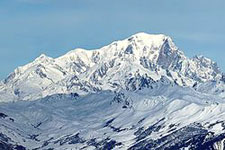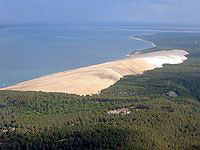VOL. 16 NO. 1
Now in our 16th year. . .

| Winter
2012
VOL. 16 NO. 1 Now in our 16th year. . . |
 |
| The Independent Traveler's Newsletter | |
| Did you know these facts about France? | ||||
| IN
THIS ISSUE:
. . . facts about France? Paris Enigmas Ici et Là
Château
de Chantilly
Saison de
Chasse - Hunting Sanglier
The Thinker
returns to
Vaison la
Romaine: France's Pompeii
Featuring:
A Pictorial Tour of Winter
Notes from
Narbonne
|
Europe is a very diverse region of the world with so many cultures - and for travelers they are all conveniently close to one another. But France, in our opinion, is quite special. France (not quite as big in area as the state of Texas) is the largest country in Western Europe and can lay claim to some other 'big' tourist attractions such as Europe's largest pine forest - the Landes Forest in Aquitaine - and along its edge the Dune du Pilat, at 107 meters Europe's highest sand dune. It stretches north to south 3 kilometers along the Atlantic Côte d'Argent and east to west 500 meters! France's Mont Blanc, 15,782 feet high and bordering Italy, is the highest mountain in Western Europe, the European Union and the Alps. With several mountain ranges, dormant volcanoes, over one hundred nineteen rivers and many more tributaries, the French landscape is one of amazing variety. France hosts more tourists annually (76.8 million in 2010) than any country in the world - followed by the US, a distant second at 59.75 million - a distinction France maintains year after year.  
Mont Blanc South Face Dune du Pilat What
helps tourists to get around in France? Well, we love Paris' easy-to-use
Métro system; and the SNCF, France's national railway, owns the
world's largest fleet of trains - most of which are TGVs - those high-speed,
silky-smooth trains that get you almost anywhere in France in 1, 2 or 3
hours. And, who makes them? Alstom, the world's largest train
manufacturer, is a French company. Another transportation mainstay
of the French economy and a leading employer is its automobile industry,
second in Europe only to Germany. Speaking of Paris, it is the largest
city in Western Europe in area, and without a doubt the most romantic
city in the world!
One
thing we all notice as we fly over France is farmland. Hundreds of
thousands of acres of farms can be seen forming that familiar green and
tan quilted pattern - meticulously laid out and tended farms that contribute
so much to the needs of Europe and the world. France has 48.2 million
acres devoted to agriculture - the most in Western Europe - and it is the
world's second largest exporter of food (after the US) owing to its mild
climate and fertile land.
We mustn't forget the wine, a staple in France both on the table at mealtimes and as a major export. In 2010 France was the top wine producing country in the world. And you can't discuss France without mentioning its cheese! France has, it is said, between 400 and 500 different cheeses, more types of cheese than any country in the world. And, what wonderful cheeses they are! Despite all these interesting facts about France, most of us do not travel there because of statistics. We crave France's excellent cuisine, and as we all know, the French have made an art of dining. Nature beckons, too. The country simply has the most beautiful scenery from green valleys to rugged mountains and 5500 kilometers of coastline along the Channel, the Atlantic and the Mediterranean - half of which remains wild and pristine. Those who love history and architecture will not be disappointed ~ there are the extremely well-preserved historic sites from Roman ruins and antiquities to soaring Gothic cathedrals and a variety of styles and periods from Medieval fortresses to 18th and 19th century elegant manoirs. Finally, what most of us who visit France come to appreciate is the unique lifestyle of the French: strong in its traditions and adhering to simple everyday routines such as walking to the market, enjoying a leisurely lunch, and valuing and preserving life in the small villages that dot the countryside. Is it any wonder that we are all fascinated by France and eager to return? |
|||
| Look
inside. . . with a click
> to learn exactly what is involved in the seasonal wild boar hunt in Provence ~ Saison de Chasse: Hunting Sanglier in the Var ~ > as a colder-than-normal winter blankets much of Europe. Take a pictorial journey with us to two départements of France - the Savoie and Var - to see winter's beauty. ~ > to accompany Arthur Gillette to the lovely hill village of Vaison la Romaine - France's Pompeii - in the Vaucluse of Provence. ~ > and you'll see that The New York Times chose Montpellier, France as one of its top 45 tourist destinations for 2012! ~ > to enjoy a brief but fascinating visit to Château de Chantilly just northeast of Paris with Arthur Gillette. ~ > for the story of The Thinker's return to Stanford after two years on loan to the North Carolina Museum of Art. ~ > where Marlane O'Neill shares with us the town's projects and a visit to a local wine producer in her Notes from Narbonne. |
PARIS
ENIGMAS . . . A Quiz on Your
Knowledge of Historic Paris
by Arthur Gillette Question from the last issue: At the Conciergerie Palace on Ile de la Cité, the oldest (ca. 1250 A. D.) tower is known as Tour Bon Bec (Good Beak Tower). Why that name? Answer: People tend to associate bon bec with bec fin, i.e. consuming magnificent gastronomy. In fact, there have been law courts in or near the Conciergerie for centuries. In the Middle Ages the accused were tortured in this tower, and passersby could hear their screams - whence 'good beak'. [Editor's note: judges and magistrates in England were called 'beaks' for their long noses in everyone else's business. Or the term may derive from Old French beccus or beck for constable and thence any authority figure.] Our new question: When the Paris Métro began at the end of the 19th century, the private company in charge decided that the entrances should have distinctive street-level architecture and organized a project competition. The commission went to Art Nouveau architect Hector Guimard, and many of his entrances are still there for us to enjoy today. Guimard, however, had not entered the competition. How then did he get the job? Contact Arthur
Gillette to take advantage of his amazing knowledge of Paris
[See the answer
to this edition's question revealed in our Spring 2012 issue.]
SPONSORING THIS ISSUE Exclusive French
Château Note Cards, perfect for sending personal notes or thank
you
next page ©1998-2012 Cold Spring Press All Rights Reserved Recommendations are not a guarantee of satisfaction and are made only to assist travelers with suggestions and web sites that we have found very useful. |
|||